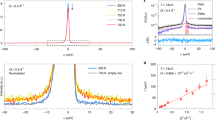Abstract
New scientific direction — nanoionics of advanced superionic conductors (ASICs) was proposed. Nanosystems of solid state ionics were divided onto two classes differing by an opposite influence of crystal structure defects on the ionic conductivity σi (energy activationE): I) nanosystems on the base compounds with initial small σi (large values ofE); and II) nanosystems of ASICs (nano-ASICs) withE ≈0.1 eV.
The fundamental challenge of nanoionics as the conservation of fast ion transport (FIT) in nano-ASICs on the level of bulk crystal was first recognized and for the providing of FIT in nano-ASICs the conception of structure-ordered (coherent) ASIC//indifferent electrode (IE) heteroboundaries was proposed. Nano-ASIC characteristic parameterP=d/λ Q (d is the thickness of ASIC layer with the defect crystal structure at the heteroboundary, and λ Q is the screening length of charge for mobile ions of the bulk of ASIC) was introduced. The criterion for a conservation of FIT in nano-ASIC isP≈1. It was shown that at the equilibrium conditions the contact potentialsV at the ASIC//IE coherent heterojunctions in nano-ASICs areV«k BT/e. Interface engineering approach “from advanced materials to advanced devices” was proposed as fundamentals for the development of applied nanoionics. The possibility for creation on the base of ASIC//IE coherent heterojunctions of the efficient energy and power devices (sensors and supercapacitors with specific capacity ≈10−4 F/cm2 and maximal frequencies 109–100 Hz,) suited for micro(nano)electronics, microsystem technology and 5 Gbit DRAM was pointed out.
Similar content being viewed by others
References
C.C. Liang, J. Electrochem. Soc.120, 1289 (1973).
K. Shahi, J.B. Wagner, Appl. Phys. Lett.37, 757 (1980).
J. Maier, Ber. Bunsenges. Phys. Chem.88, 1057 (1984).
D.O. Raleigh, H.R. Crowe, J. Electrochem. Soc.118, 79 (1971).
A.L. Despotuli, V.I. Nikolaichik, Solid State Ionics60, 275 (1993).
A.L Despotuli, A.V. Andreeva, e-publication, http://preprint.chemweb.com/physchem/0309001 (2003).
B. Owens, J. Power Sources90, 2 (2000).
A.L Despotuli, A.V. Andreeva, Microsystem engineering (Rus)11, 2 (2003).
A.L Despotuli, A.V. Andreeva, Microsystem engineering (Rus)12, 2 (2003).
A.L. Despotuli, A.V. Andreeva, e-publication, http://preprint.chemweb.com/physchem/0306011 (2003)
K.J. Lehovec, J. Chem. Phys.21, 1123 (1953).
S. Chandra, Superionic Solids, North-Holland Publishing Company, 1981, p. 404.
A.L. Despotuli, L.A. Despotuli, Phys. Solid State (Rus)39, 1544 (1997).
A.L. Despotuli, in: New Trends in Intercalation Compound for Energy Storage. NATO-SCIENCE SERIES. Volume61 (C. Julien et al., Eds.) Kluwer Academic Publishers, Dordrecht-Boston-London, 2002, p. 455.
A.L. Despotuli, V.I. Levashov, e-publication, http://preprint.chemweb.com/inorgchem/0208001 (2002).
A.L. Despotuli, V.I. Levashov, L.A. Matveeva, Electrochemistry (Rus)39, 526 (2003).
P. Keblinski, J. Eggebrecht, D. Wolf, S.R. Phillpot, J. Chem. Phys.113, 282 (2000).
A.A. Volkov, G.V. Kozlov, G.I. Mirzoev, V.G. Goffman, Letters in JETP (Rus)38, 182 (1983).
J. Maier, Solid State Ionics86–88, 55 (1996).
J.-S. Lee, St. Adams, J. Maier, Solid State Ionics136–137, 1261 (2000).
J. Maier, Solid State Ionics131, 13 (2000).
J. Maier, Solid State Ionics154–155, 291 (2002).
J. Maier, Solid State Ionics157, 327 (2003).
J. Maier, Solid State Ionics148, 367 (2002).
J. Maier, Z. Phys. Chem.217 (4), 415 (2003).
N. Sata, K. Eberman, K. Eberl, J. Maier, Nature408, 946 (2000).
J. Jamnik, J. Maier, Phys. Chem. Chem. Phys.5, 5215 (2003).
A.L. Despotuli, A.A. Shestakov, N.V. Lichkova, Solid State Ionics70/71, 130 (1994).
J.H. Choy, N.G. Park, Y.I. Kim, S.H. Hwang, J. Phys. Chem.99, 7845 (1995).
J.H. Choy, Y.I. Kim, S.J. Hwang, J. Phys. Chem. B102, 9191 (1998).
A.L. Despotuli, A.V. Andreeva, in: Proceeding of International Workshop "Micro Robots, Micro Machines and Micro Systems", Institute for Problems in Mechanics RAS, Moscow, April 24–25, 2003, p. 129.
A.L. Despotuli, A.V. Andreeva, in: Book of Abstracts "7th International Meeting Fundamental Challenges of Solid State Ionics", Chernogolovka, June 16–18, 2004, p. 22.
I.M. Lifshitz, Y.E. Geguzin, Phys. Solid State (Rus)7, 62 (1965).
V.N. Chebotin, L.M. Solov'eva, Electrochemistry (Rus)4, 858 (1968).
E.A. Ukshe, N.G. Bukun, Electrochemistry (Rus)26, 1373 (1990).
T. Watanabe, Res. Mechanica11, 47 (1984).
T. Watanabe, Acta Mater.47, 4171 (1999).
T. Watanabe, in: Book of abstracts "International Conference "Interfaces in advanced materials", Chernogolovka, May 26–30, 2003, p. 2.
A.I. Il'in, A.V. Andreeva, B.N. Tolkunov, Mat. Sci. Forum.206, 625 (1996).
O.V. Kononenk, A.V. Andreeva, A.I. Il'in, V.N. Matveev, in: MRS-Proceedings, 2002, p. 574.
A.V. Andreeva, N.M. Talijan et al., e-publication, http://preprint.chemweb.com/inorgchem/0302001 (2003).
M. Backhaus-Ricoult, M.-F. Trichet, Solid State Ionics150, 143 (2002).
R. Röttger, H. Schmalzried, Solid State Ionics150, 131 (2002).
D.M. Kolb, Surface Science500, 722 (2002).
Zh.I. Alferov, Uspehi Phys. Sci.172, 1068 (2002).
A.V. Andreeva, A.L. Despotuli, in: Book of abstracts "International Conference Interfaces in advanced materials", Chernogolovka, May 26–30, 2003, p. 32.
A.L. Despotuli, A.V. Andreeva, in: Book of extending abstracts. International Conference "INTERMATIC-2003", Moscow, June 9–12, 2003, p. 156.
A.V. Andreeva, in: Proceeding of 5th Russian Conferene on Physicochemistry of Ultra-Dispersoid System (V.F. Petrunin, Ed.) MEPI, Moscow, 2000, p. 32.
A.L. Despotuli, N.V. Lichkova, N.A. Minenkova, S.V. Nosenko, Electrochemistry (Rus)26, 1524 (1990).
A.V. Andreeva, Surface: Physics, Chemistry, Mechanics46, 117 (1990).
A.V. Andreeva, A.A. Firsova, Preprint of IMT AN USSR, Chernogolovka, 1990, p. 44.
A.V. Andreeva, Mat. Sci. Forum69, 111 (1991).
A.V. Andreeva, D.L. Meiler, Crystal properties and preparation35—38, 358 (1991).
T. Ochs, S. Köstlmeier, C. Elsässer, Integr. Ferroelectrics32, 959 (2000).
M. Kiguchi, H. Inoue, T. Sasaki et al., Surf. Sci.522, 84 (2003).
S. Bredikhin, T. Hattori, M. Ishigame, Phys. Rev. B50, 2444 (1994).
http://www.skeleton-technologies.com
P. Bergamo, S. Asgari, H. Wang, D. Maniezzo, L. Yip, R. Hudson, K. Yao, D. Estrin, IEEE Transactions on Mobile Computing3, 211 (2004).
S. Ezhilvalavan, T. Tseng, Materials Chemistry and Physics65, 227 (2000).
R.E. Jones, P. Zurcher, P. Chu et al., Microeletronic Engineering29, 11 (1995).
http://www.iapplianceweb.com/story/oeg20030624 s0046.htm
Author information
Authors and Affiliations
Additional information
The paper is dedicated to the memory of Prof. E.A. Ukshe who had supported the ideas of nanoionics in 1992.
Rights and permissions
About this article
Cite this article
Despotuli, A.L., Andreeva, A.V. & Rambabu, B. Nanoionics of advanced superionic conductors. Ionics 11, 306–314 (2005). https://doi.org/10.1007/BF02430394
Received:
Accepted:
Issue Date:
DOI: https://doi.org/10.1007/BF02430394




